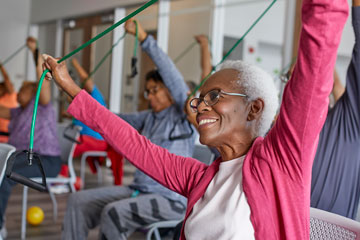Addressing The Health Needs of The Whole Person
 (NewsUSA)
(NewsUSA) – Social, economic and environmental factors play a key role in people’s health – where they live, learn work, and play. These circumstances are shaped by the distribution of wealth, power and resources at global, national and local levels.Identifying these so-called "social determinants of health" helps doctors determine the root causes of their patients’ medical conditions and is critical to improving whole-person health. The Physicians Foundation found that nearly 90 percent of doctors have patients whose health is affected by these key factors.1Below are some examples to illustrate how social factors can affect you and your health:* Loneliness and social isolation. More than a quarter of the U.S. population live alone. Loneliness and social isolation are associated with increased mortality and poor health outcomes. Identifying individuals at risk for these factors allows doctors to recommend prevention and care strategies to improve their patients’ health.* Food insecurity. The U.S. Department of Agriculture defines food insecurity as a lack of consistent access to enough food for a healthy life. According to Feeding America, food insecurity exists in every state in the United States. Seniors face challenges that put them at risk of food insecurity, such as being on a fixed income and having to choose between buying food or medicine, or struggling to obtain food without reliable transportation.* Transportation Barriers. A lack of transportation affects an individual’s health and well-being – from accessing health care services and healthy food options to maintaining social connections. Lack of transportation is the leading cause of patient no-shows for medical appointments, and missed appointments are associated with increased medical care costs and increased emergency room visits.2But many Medicare Advantage plans, provided by private health insurers such as Humana, offer their members health and wellness benefits, programs and services to help address social determinants, with rides to medical appointments, meal benefits, social interaction and screening for food insecurity.Humana is working to address social determinants of health through its Bold Goal, by working with Humana care teams, physicians, nonprofit organizations, and business and government leaders to identify, screen and refer members to community resources and long-term support.The Bold Goal is a population health strategy to help improve the health of the communities we serve by 20 percent by 2020 and beyond.For more information, visit populationhealth.humana.com. 1 https://physiciansfoundation.org/wp-content/uploads/2018/09/physicians-survey-results-final-2018.pdf2 http://www.aha.org/transportation Y0040_GHHKP2EEN_C
– Social, economic and environmental factors play a key role in people’s health – where they live, learn work, and play. These circumstances are shaped by the distribution of wealth, power and resources at global, national and local levels.Identifying these so-called "social determinants of health" helps doctors determine the root causes of their patients’ medical conditions and is critical to improving whole-person health. The Physicians Foundation found that nearly 90 percent of doctors have patients whose health is affected by these key factors.1Below are some examples to illustrate how social factors can affect you and your health:* Loneliness and social isolation. More than a quarter of the U.S. population live alone. Loneliness and social isolation are associated with increased mortality and poor health outcomes. Identifying individuals at risk for these factors allows doctors to recommend prevention and care strategies to improve their patients’ health.* Food insecurity. The U.S. Department of Agriculture defines food insecurity as a lack of consistent access to enough food for a healthy life. According to Feeding America, food insecurity exists in every state in the United States. Seniors face challenges that put them at risk of food insecurity, such as being on a fixed income and having to choose between buying food or medicine, or struggling to obtain food without reliable transportation.* Transportation Barriers. A lack of transportation affects an individual’s health and well-being – from accessing health care services and healthy food options to maintaining social connections. Lack of transportation is the leading cause of patient no-shows for medical appointments, and missed appointments are associated with increased medical care costs and increased emergency room visits.2But many Medicare Advantage plans, provided by private health insurers such as Humana, offer their members health and wellness benefits, programs and services to help address social determinants, with rides to medical appointments, meal benefits, social interaction and screening for food insecurity.Humana is working to address social determinants of health through its Bold Goal, by working with Humana care teams, physicians, nonprofit organizations, and business and government leaders to identify, screen and refer members to community resources and long-term support.The Bold Goal is a population health strategy to help improve the health of the communities we serve by 20 percent by 2020 and beyond.For more information, visit populationhealth.humana.com. 1 https://physiciansfoundation.org/wp-content/uploads/2018/09/physicians-survey-results-final-2018.pdf2 http://www.aha.org/transportation Y0040_GHHKP2EEN_CYou may also be interested in
Web Design Agency Singapore
Singapore Web Design
Comments
Post a Comment